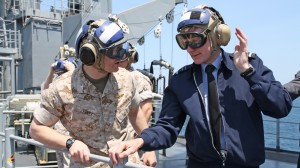2015-05-28 By Maj. Paul Greenberg
5/26/15
USS WASP, At Sea — As the first operational test of the F-35B Lightning II takes place aboard the USS Wasp this week, service members from the United Kingdom are working alongside their U.S. Navy and Marine Corps counterparts to assess the integration of the F-35B into amphibious military operations.
“United Kingdom participation in the F-35 program has been absolutely critical to our success,” said Lt. Gen. Chris Bogdan, Program Executive Officer for the F-35 Lightning II Joint Program Office. “Since the beginning, UK test pilots and engineers have been fully integrated and work shoulder-to shoulder with us as we deliver the F-35 to the warfighter.”
Sixteen Royal Navy and Royal Air Force members embedded aboard the ship during the operational tests. They serve as F-35 operational assessors, ship integration team members, aircraft technicians and maintenance crews.
The Royal Navy’s vision for tactical integration of the F-35B into their current arsenal is similar to the Marine Corps’ plan to integrate the F-35 with legacy aircraft, such as the AV-8B Harrier and the F/A-18 Hornet, and gradually phase out legacy aircraft over the coming decades.
“By 2020, U.K. combat airpower will consist of Typhoon and F-35B Lightning II, a highly potent and capable mix of fourth and fifth generation fighter aircraft. With Typhoon already established as one of the premier multi-role fighters in the world, the F-35 brings a complementary next-generation level of survivability and lethality. This will ultimately provide the UK with an unprecedented level of capability in a single platform,” said Royal Navy Lt. Cmdr. Neil Mathieson, the UK’s F-35B Ship Integration Lead.

A mechanical engineer by trade, Mathieson is working with the Marine Corps aboard USS Wasp for the duration of OT-1.
Mathieson explained that a range of advanced sensors, combined with increased processing power, enables the F-35B to fuse the vast array of information collected into a single picture. This equips the F-35 pilot with a level of situational awareness previously unavailable within a fighter cockpit and an ability to share this instantaneous, high-fidelity view of ongoing operations with other platforms at sea, in the air, or on the ground through advanced datalinks.
“The unique, low observable nature of the F-35 will also allow unprecedented access to very high-threat environments, allowing the U.K. to conduct operations across the full range of operational scenarios, day or night, in fair or inclement weather,” said Mathieson.
During the two week operational test, the Marine Corps and U.K. counterparts are assessing the integration of the F-35B while operating across a wide array of flight and deck operations. Specific OT-1 objectives include demonstrating and assessing day and night flight operations in varying aircraft configurations; digital interoperability of aircraft and ship systems; F-35B landing signal officer’s launch and recovery software; day and night weapons loading; and all aspects of maintenance, logistics, and sustainment support of the F-35B while deployed at sea. Additionally, the joint and international team is working closely with Naval Sea Systems Command to assess specific modifications made to USS Wasp. This will be particularly beneficial for the U.K.’s future program, which will include integration of the F-35B with their new class of amphibious ships.
“Our Queen Elizabeth Class carriers are the largest and most powerful warships ever built in the U.K.,” said Mathieson. “They are capable of the widest range of roles, from defense diplomacy and humanitarian assistance to full combat operations, providing flexibility and choice throughout their 50-year life.”
In February, the United Kingdom stood up their first F-35 squadron at Edwards Air Force Base, California. The historic 17 (Reserve) Squadron is now responsible for the entire operational test and evaluation of the UK’s F-35s. Personnel from 17 (R) Squadron, comprised of engineers and pilots from the Royal Air Force and Royal Navy, fly and maintain the two UK F-35B jets independently from their U.S. colleagues.
“The U.K. team is involved in every facet of F-35B maintenance during OT-1,” said U.S. Marine Corps Lt. Col. Michael Dehner, the Department of the Navy F-35 Operational Test Director. “That includes avionics, air frames, power lines, quality assurance and flight equipment. They’re going to glean valuable lessons that will be critically useful as they move from the developmental to the operational phase of F-35B integration.”
U.K. F-35B pilots will begin operating the next generation stealth fighter from home bases in England starting in 2018, and are on track to fly from Queen Elizabeth Class aircraft carriers in 2020. The U.K. has played a major role in the program throughout the System Design and Demonstration phase, and has a program of record to procure the F-35B in the coming years.


